
Trinity Industries, Inc. Investor Presentation May 2016 Investor Contact: TrinityInvestorRelations@trin.net Website: www.trin.net Exhibit 99.1
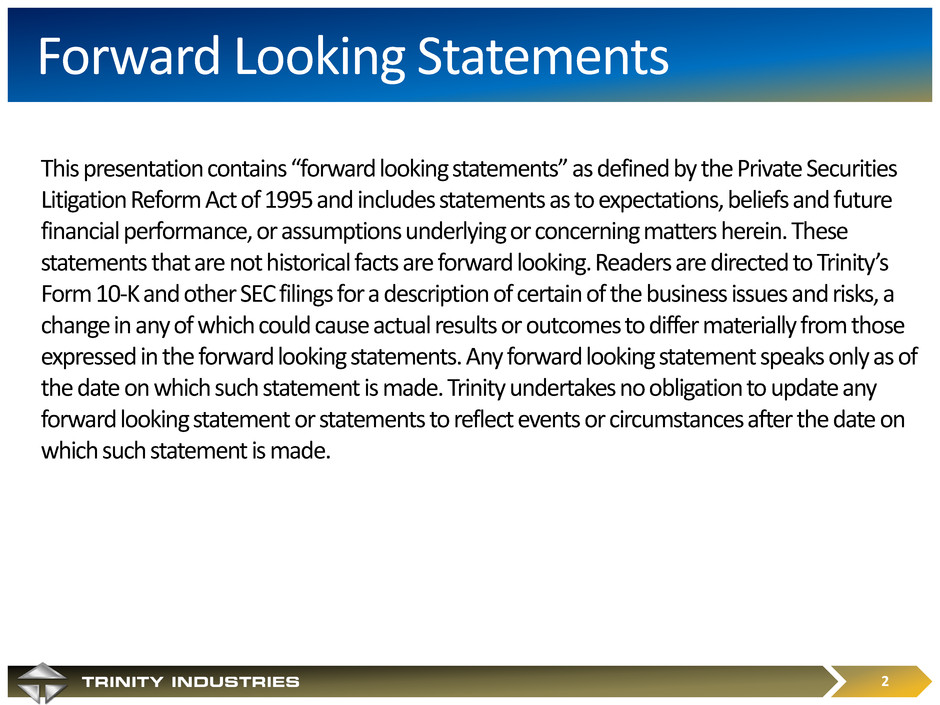
A Premiere Diversified Industrial Company This presentation contains “forward looking statements” as defined by the Private Securities Litigation Reform Act of 1995 and includes statements as to expectations, beliefs and future financial performance, or assumptions underlying or concerning matters herein. These statements that are not historical facts are forward looking. Readers are directed to Trinity’s Form 10-K and other SEC filings for a description of certain of the business issues and risks, a change in any of which could cause actual results or outcomes to differ materially from those expressed in the forward looking statements. Any forward looking statement speaks only as of the date on which such statement is made. Trinity undertakes no obligation to update any forward looking statement or statements to reflect events or circumstances after the date on which such statement is made. 2 Forward Looking Statements

A Premiere Diversified Industrial Company Agenda I. Overview II. Key Investment Considerations III. Strategy and Vision IV. Financial Highlights V. Appendix 3

A Premiere Diversified Industrial Company • Trinity Industries, Inc. is a diversified industrial company that owns a variety of market-leading businesses providing products and services to the energy, transportation, chemical, and construction sectors • Trinity operates through five business segments: • Rail Group • Railcar Leasing and Management Services Group (“Leasing”) • Inland Barge Group • Construction Products Group (“CPG”) • Energy Equipment Group (“EEG”) • The Company serves its customers through manufacturing facilities located in the United States, Mexico, and Canada and had approximately 22,030 employees at the end of 2015 • Total Revenue and EBITDA for the LTM 03/16 was $5.95 billion and $1.59 billion, respectively 4 I. Trinity Industries, Inc. Overview External Revenue by Business Group(1) All share and per share information has been retroactively adjusted to reflect the 2-for-1 stock split effective in June 2014. All Footnotes throughout the presentation are listed on Slide 27. Rev e n u e (2) ($mm) E P S
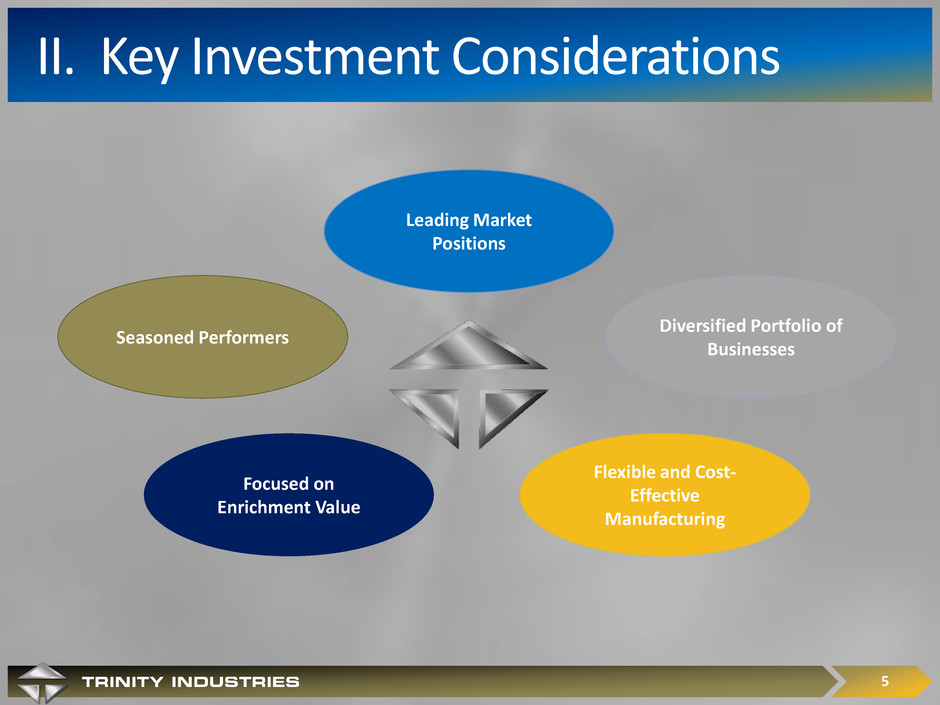
A Premiere Diversified Industrial Company 5 II. Key Investment Considerations Leading Market Positions Diversified Portfolio of Businesses Flexible and Cost- Effective Manufacturing Seasoned Performers Focused on Enrichment Value

A Premiere Diversified Industrial Company Rail Group Leading manufacturer of railcars Leading manufacturer of railcar axles Leading manufacturer of railcar coupling devices Railcar Leasing and Management Services Group Leading provider of railcar leasing and management services Inland Barge Group Leading manufacturer of inland barges and fiberglass barge covers in the United States Construction Products Group Leading full-line manufacturer of highway guardrail and crash cushions in the United States Leading producer and distributor of lightweight and natural aggregates in the western and southwestern United States Energy Equipment Group Leading manufacturer of structural wind towers Leading manufacturer of storage and distribution containers and tank heads for pressure and non- pressure vessels Leading manufacturer of steel structures for electricity transmission and distribution 6 Leading Market Positions in North America

A Premiere Diversified Industrial Company 7 Diversified Portfolio of Businesses PRESENT (LTM 03/16) Elevating Our Financial Performance Total Revenues = $5.9 B PAST (FY 2000) Total Revenues = $2.7 B Trinity’s long-term goal is to establish sustainable earnings growth over economic cycles. All Footnotes throughout the presentation are listed on Slide 27. Operating Profit (1) (2) (2) Revenue Revenue Operating Profit (1) (2) (2) We strive to outperform prior cyclical peaks with higher EPS and better returns, and raise the earnings floor and improve balance sheet strength during cyclical downturns -$0.50 $0.00 $0.50 $1.00 $1.50 $2.00 $2.50 $3.00 $3.50 $4.00 $4.50 $5.00 $5.50 2003 2004 2005 2006 2007 2008 2009 2010 2011 2012 2013 2014 2015 LTM 03/16 Calendar Year EPS (3)

A Premiere Diversified Industrial Company 8 Flexible and Cost-Effective Manufacturing In recent years, Trinity has invested in its manufacturing footprint to establish “multi-purpose” facilities, enhancing its flexible manufacturing footprint. Flexibility Cost-Effective Trinity's manufacturing flexibility across products and business segments enhances our ability to opportunistically respond to changes in market demand Trinity’s manufacturing scale, vertical integration, and presence in the Southern U.S. and Mexico provides cost effective benefits across multiple business segments

A Premiere Diversified Industrial Company 9 Focused on Enrichment Value Ex te rn al R ep o rt in g G rou p s Ope ra tio n al F ocu s A re as Rail Leasing Construction Energy Inland Barge Customer Sharing Internal Component Sourcing Shared Best Manufacturing Practices Facility Optimization Centralized Cost Savings Trinity focuses on collaboration across business segments… …generating synergies that enhance value and ultimately provide competitive benefits

A Premiere Diversified Industrial Company Incorporated in 1933 with a strong corporate culture and commitment to Company values Seasoned management team knows how to assess the market, proactively plan for cycles and quickly adapt to changing market conditions Cost-effective and flexible manufacturing footprint in the Southern United States and Mexico is a competitive advantage for many of our product lines Significant liquidity position of approximately $2.08 billion and a strong balance sheet at quarter end March 31, 2016 Track record of maintaining a healthy liquidity position across the business cycle; “investment-grade” credit ratings from two of the three principal rating agencies S&P – Rating of “BBB-” with an Outlook of “Stable” Fitch – Rating of “BBB-” with an Outlook of “Stable” Moody’s – Rating of “Ba1” with an Outlook of “Stable” 10 Seasoned Performer Across Market Conditions

A Premiere Diversified Industrial Company 11 III. Strategy and Vision: Operational Strategically Grow the Lease Fleet Selectively Build our Backlogs Diversify Through Organic Growth Acquire Complementary Product Portfolios Be a premier, diversified industrial company that generates superior earnings and returns for shareholders Maximize Manufacturing Efficiency

A Premiere Diversified Industrial Company 12 Strategy and Vision: Financial Maintain a conservative and liquid balance sheet to be attractively positioned to capitalize on opportunities Working Capital Capital Expenditures Acquisitions Shareholder Distributions Cash, Cash Equivalents, & Short Term Marketable Securities $836 Corporate Revolver Availability 507 Warehouse Availability 741 Total Available Liquidity $2,084 mm Balance Sheet Debt ~ $3.2 B (1) Available Liquidity ~ $2.1 B Equity ~ $4.1 B Recourse Debt Senior Notes (1) $400 Convertible Subordinated Notes(1) 449 Capital Leasing Obligations(1) 35 Total Recourse $884 mm Non-Recourse Leasing Debt(2) Warehouse Facility(1) $259 Long-term Financings: Wholly-Owned(1) 672 Partially-Owned(1) 1,430 Total Non-Recourse Leasing $2,361 mm As of 03/31/16 All Footnotes throughout the presentation are listed on Slide 27.

A Premiere Diversified Industrial Company 13 Strategy and Vision: RIV Platform ▪ Railcar Investment Vehicles, or “RIVs”, are customized portfolios of leased railcars for institutional investors and other entities that are developed and managed by TrinityRail ▪ TrinityRail is the first in the industry to create a platform of RIVs for institutional investors. Over the last decade, we have placed approximately $5.0 billion to various RIVs (1) ▪ Institutional investors continue to invest in RIVs developed and managed by TrinityRail because of the scale and diversity of our products and services, the strength of our commercial relationships, our “cradle to grave” asset expertise, and our track record of value-creating investments ▪ Our current financial guidance incorporates $300 - 400 million of leased railcar sales to RIVs in 2016 (2) All Footnotes throughout the presentation are listed on Slide 27.
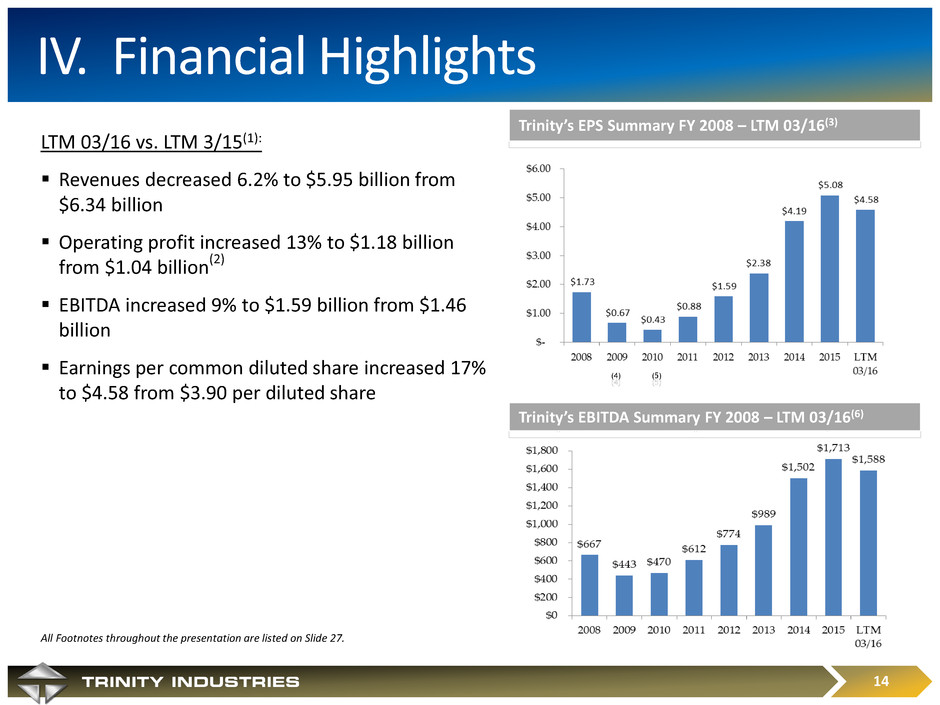
A Premiere Diversified Industrial Company 14 IV. Financial Highlights Trinity’s EPS Summary FY 2008 – LTM 03/16(3) LTM 03/16 vs. LTM 3/15(1): Revenues decreased 6.2% to $5.95 billion from $6.34 billion Operating profit increased 13% to $1.18 billion from $1.04 billion (2) EBITDA increased 9% to $1.59 billion from $1.46 billion Earnings per common diluted share increased 17% to $4.58 from $3.90 per diluted share Trinity’s EBITDA Summary FY 2008 – LTM 03/16(6) All Footnotes throughout the presentation are listed on Slide 27. (4) (5)

A Premiere Diversified Industrial Company 15 Guidance and Outlook (As of April 22, 2016) Rail Group Revenues ~ $3.1 billion in FY 2016 OP Margin ~ 15% in FY 2016 Shipments ~ 27,000 in FY 2016 Leasing Group Revenues from Operations ~ $700mm in FY 2016 OP from Operations ~ $300mm in FY 2016 Sales of leased railcars ~ $300 - 400mm in FY 2016 Revenue Eliminations ~ $1.15 billion in FY 2016 OP Elimination Impact ~ $215mm in FY 2016 Gross Cash Investment in Lease Fleet ~ $925mm in FY 2016 Inland Barge Group Revenues ~ $420mm in FY 2016 OP Margin ~ 11% in FY 2016 Construction Products Group Revenues ~ $560mm in FY 2016 OP Margin ~ 11% in FY 2016 Energy Equipment Group Revenues ~ $1.0 billion in FY 2016 OP Margin ~ 12% in FY 2016 Total Company EPS ~ $2.00 – 2.30 in FY 2016 Manufacturing and Corporate Capital Expenditures ~ $150 - 200mm in FY 2016 Elimination Impact of Net Income Attributable to Noncontrolling Interest ~ $17mm in FY 2016 Any forward-looking statements made by the Company speak only as of the date on which they are made. The Company is under no obligation to, and expressly disclaims any obligation to, update or alter its forward-looking statements, whether as a result of new information, subsequent events or otherwise.

A Premiere Diversified Industrial Company 16 Appendix: Operating Business Summaries

A Premiere Diversified Industrial Company 17 Rail Group Business Conditions/Demand Outlook Market Positioning Current Performance(4) Rail Group Revenues and OP Margin (1) Leading manufacturer of railcars, railcar axles, and coupling devices in North America Broadest product offering for railcar manufacturing in North America Networking of customers between railcar sales and railcar leasing Focus on new and advanced engineering designs Centralized sourcing provides cost savings Streamlined manufacturing efficiencies Trinity delivered 32,730 railcars representing 40% of industry shipments during LTM 03/16; Trinity received orders for 18,900 railcars representing 37% of the industry total during LTM 03/16 Trinity’s order backlog of 43,360 railcars accounts for 47% of industry backlog as of LTM 03/16 and includes a broad mix of railcar types across many industrial sectors; Trinity’s industry- leading $4.72 billion order backlog extends into 2020 Reducing production footprint and throughput to align with lower market demand and converting production lines to accommodate the significant shift in product mix for 2016 All Footnotes throughout the presentation are listed on Slide 27. (2)
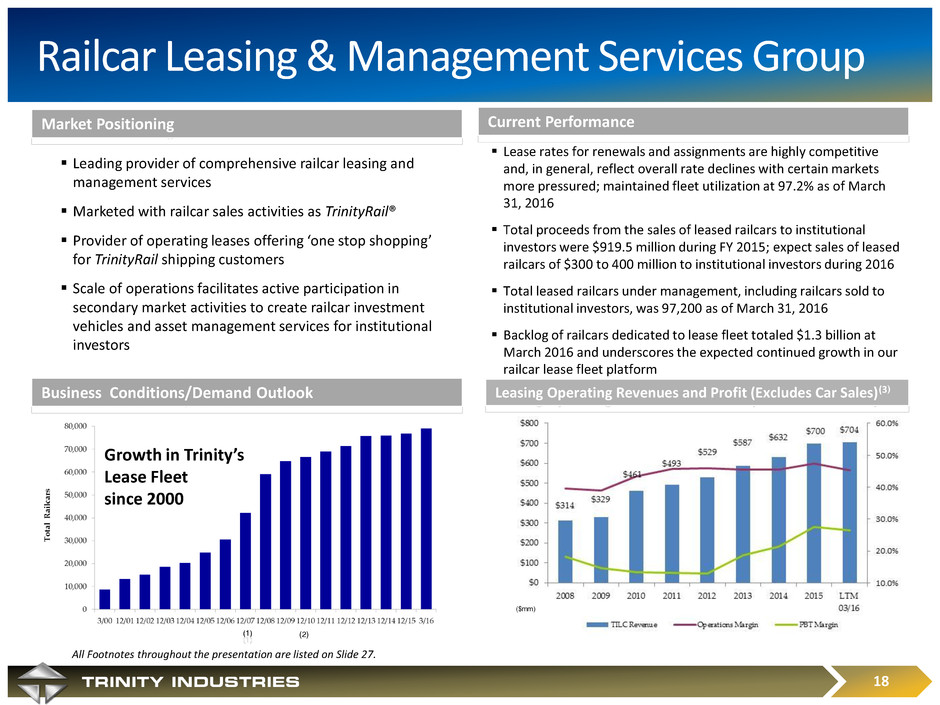
A Premiere Diversified Industrial Company 18 Railcar Leasing & Management Services Group Business Conditions/Demand Outlook Market Positioning Current Performance Leading provider of comprehensive railcar leasing and management services Marketed with railcar sales activities as TrinityRail® Provider of operating leases offering ‘one stop shopping’ for TrinityRail shipping customers Scale of operations facilitates active participation in secondary market activities to create railcar investment vehicles and asset management services for institutional investors Lease rates for renewals and assignments are highly competitive and, in general, reflect overall rate declines with certain markets more pressured; maintained fleet utilization at 97.2% as of March 31, 2016 Total proceeds from the sales of leased railcars to institutional investors were $919.5 million during FY 2015; expect sales of leased railcars of $300 to 400 million to institutional investors during 2016 Total leased railcars under management, including railcars sold to institutional investors, was 97,200 as of March 31, 2016 Backlog of railcars dedicated to lease fleet totaled $1.3 billion at March 2016 and underscores the expected continued growth in our railcar lease fleet platform Leasing Operating Revenues and Profit (Excludes Car Sales)(3) All Footnotes throughout the presentation are listed on Slide 27. (2) Growth in Trinity’s Lease Fleet since 2000 (1) (2)
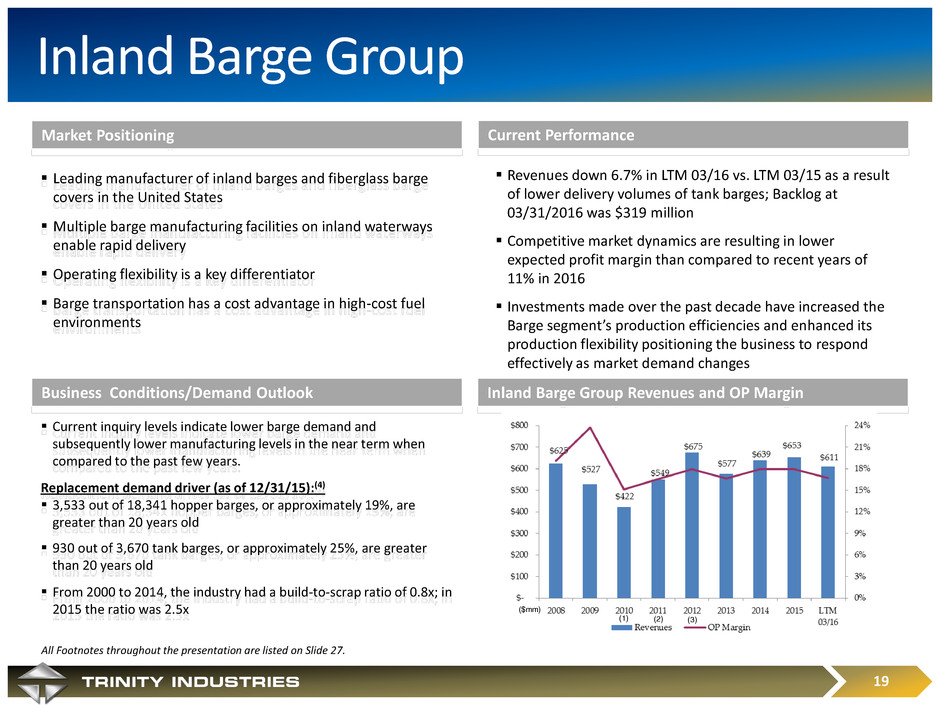
A Premiere Diversified Industrial Company 19 Inland Barge Group Business Conditions/Demand Outlook Market Positioning Current Performance Inland Barge Group Revenues and OP Margin Leading manufacturer of inland barges and fiberglass barge covers in the United States Multiple barge manufacturing facilities on inland waterways enable rapid delivery Operating flexibility is a key differentiator Barge transportation has a cost advantage in high-cost fuel environments Revenues down 6.7% in LTM 03/16 vs. LTM 03/15 as a result of lower delivery volumes of tank barges; Backlog at 03/31/2016 was $319 million Competitive market dynamics are resulting in lower expected profit margin than compared to recent years of 11% in 2016 Investments made over the past decade have increased the Barge segment’s production efficiencies and enhanced its production flexibility positioning the business to respond effectively as market demand changes Current inquiry levels indicate lower barge demand and subsequently lower manufacturing levels in the near term when compared to the past few years. Replacement demand driver (as of 12/31/15):(4) 3,533 out of 18,341 hopper barges, or approximately 19%, are greater than 20 years old 930 out of 3,670 tank barges, or approximately 25%, are greater than 20 years old From 2000 to 2014, the industry had a build-to-scrap ratio of 0.8x; in 2015 the ratio was 2.5x All Footnotes throughout the presentation are listed on Slide 27. (2) (3) ($mm) (1)
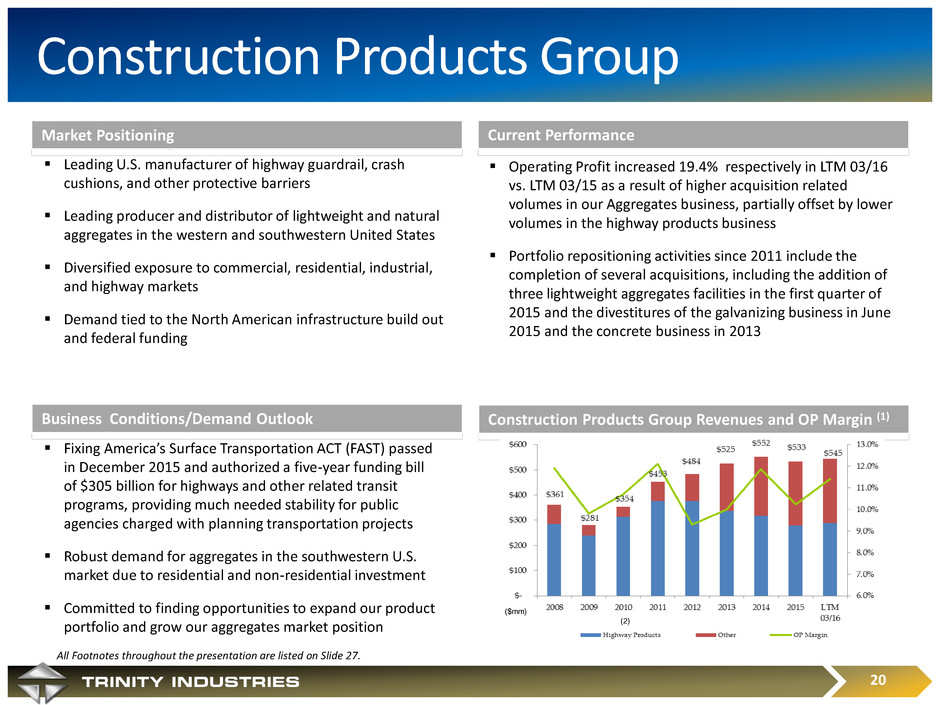
A Premiere Diversified Industrial Company 20 Construction Products Group Business Conditions/Demand Outlook Market Positioning Current Performance Construction Products Group Revenues and OP Margin (1) Leading U.S. manufacturer of highway guardrail, crash cushions, and other protective barriers Leading producer and distributor of lightweight and natural aggregates in the western and southwestern United States Diversified exposure to commercial, residential, industrial, and highway markets Demand tied to the North American infrastructure build out and federal funding Operating Profit increased 19.4% respectively in LTM 03/16 vs. LTM 03/15 as a result of higher acquisition related volumes in our Aggregates business, partially offset by lower volumes in the highway products business Portfolio repositioning activities since 2011 include the completion of several acquisitions, including the addition of three lightweight aggregates facilities in the first quarter of 2015 and the divestitures of the galvanizing business in June 2015 and the concrete business in 2013 Fixing America’s Surface Transportation ACT (FAST) passed in December 2015 and authorized a five-year funding bill of $305 billion for highways and other related transit programs, providing much needed stability for public agencies charged with planning transportation projects Robust demand for aggregates in the southwestern U.S. market due to residential and non-residential investment Committed to finding opportunities to expand our product portfolio and grow our aggregates market position All Footnotes throughout the presentation are listed on Slide 27. (2) ($mm)

A Premiere Diversified Industrial Company 21 Energy Equipment Group Business Conditions/Demand Outlook Market Positioning Current Performance Energy Equipment Group Revenues and OP Margin Leading manufacturer of wind towers, steel utility structures, storage and distribution containers and tank heads for pressure and non-pressure vessels, and cryogenic transportation equipment used to store and transport liquefied gases in North America Low-cost manufacturer with principal storage container production in prime energy market locations Wind Towers: Backlog of $263 million as of 03/31/16 provides solid visibility over our planned production in 2016; beginning to see indications of future demand as a result of new federal tax incentive Total Business Segment: Operating Profit increased 23.4% in LTM 03/16 vs. LTM 03/15 as a result of higher wind tower production partially offset by lower volumes in the other segment businesses. Recent five-year spending bill passed by the federal government in December 2015 included a tax incentive for wind power energy through 2019; the multi-year incentive provides developers the necessary stable planning environment to develop wind projects The current market for utility structures is competitive; long- term demand fundamentals remain positive due to expected future growth in investment spending, especially connecting renewable energy to the grid due to the production tax credit The storage container industry is highly competitive and experiencing pricing pressure from current market conditions; long-term demand fundamentals are positive given the significant investment by chemical companies along the Gulf ($mm)

A Premiere Diversified Industrial Company 22 How TrinityRail’s RIV platform works Sources of Railcars for TrinityRail’s RIV platform Newly built leased railcars from TrinityRail Railcars acquired in secondary market Railcars from TrinityRail’s Wholly-Owned Fleet (i.e., “Reservoir of railcars”) TrinityRail’s Managed Fleet TrinityRail’s RIV platform ▪ Over the last decade, we have placed approximately $5.0 billion to various RIVs(1) All Footnotes throughout the presentation are listed on Slide 27.

A Premiere Diversified Industrial Company 23 Value proposition for institutional investors ▪ Railcars are a critical component of North America’s transportation infrastructure, transporting a diverse range of commodities, intermediate goods, and finished products ▪ Stable, hard asset investments with attractive returns and an inflationary hedge component ▪ Long-lived assets with an average useful life of ~35-40 years ▪ Long term shift of railcar ownership from shippers & railroads towards third party lessors like TrinityRail Why invest in leased railcars? Why align with TrinityRail? ▪ Scale and diversity of railcar manufacturing – Largest manufacturer of railcars in North America – Most diversified railcar product line available in North America ▪ Strength and breadth of commercial relationships – Currently responsible for the leasing and management of >97,000 railcars ▪ “Cradle to grave” asset expertise including engineering, manufacturing, maintenance services, leasing and management services ▪ Integrated business model that provides market intelligence on the markets we serve and our customers’ ongoing needs ▪ Track record of executing value-creating transactions with sophisticated institutional partners
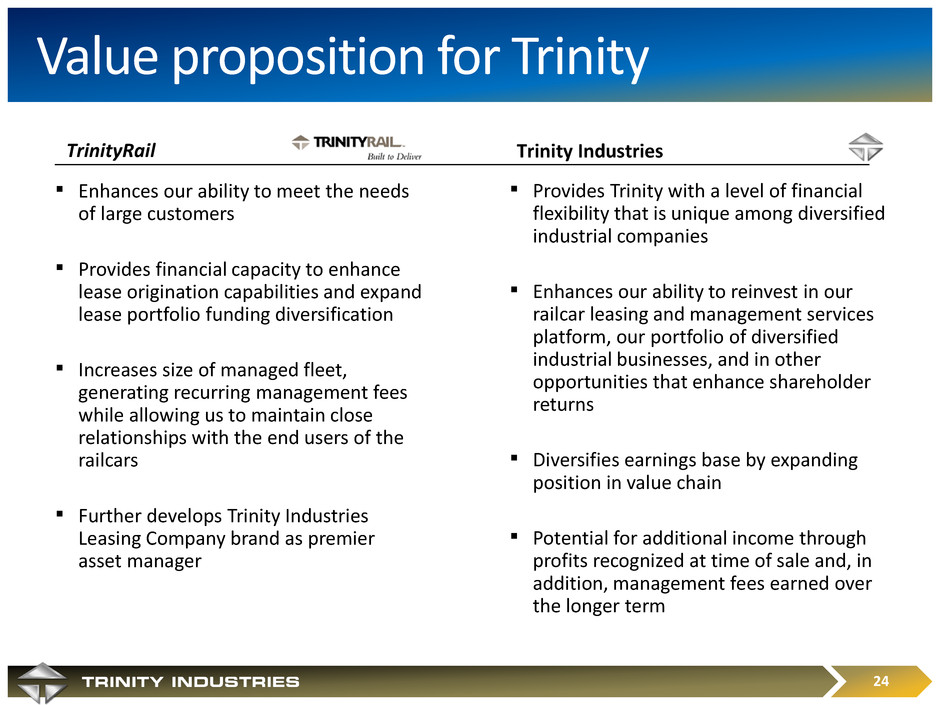
A Premiere Diversified Industrial Company 24 Value proposition for Trinity ▪ Enhances our ability to meet the needs of large customers ▪ Provides financial capacity to enhance lease origination capabilities and expand lease portfolio funding diversification ▪ Increases size of managed fleet, generating recurring management fees while allowing us to maintain close relationships with the end users of the railcars ▪ Further develops Trinity Industries Leasing Company brand as premier asset manager TrinityRail Trinity Industries ▪ Provides Trinity with a level of financial flexibility that is unique among diversified industrial companies ▪ Enhances our ability to reinvest in our railcar leasing and management services platform, our portfolio of diversified industrial businesses, and in other opportunities that enhance shareholder returns ▪ Diversifies earnings base by expanding position in value chain ▪ Potential for additional income through profits recognized at time of sale and, in addition, management fees earned over the longer term
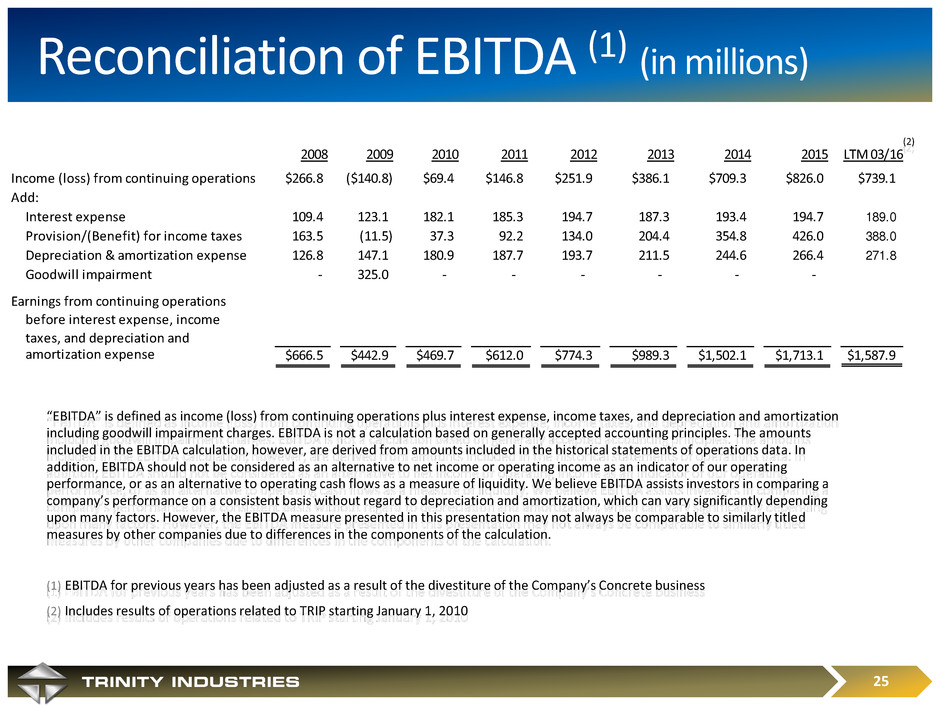
A Premiere Diversified Industrial Company 25 Reconciliation of EBITDA (1) (in millions) “EBITDA” is defined as income (loss) from continuing operations plus interest expense, income taxes, and depreciation and amortization including goodwill impairment charges. EBITDA is not a calculation based on generally accepted accounting principles. The amounts included in the EBITDA calculation, however, are derived from amounts included in the historical statements of operations data. In addition, EBITDA should not be considered as an alternative to net income or operating income as an indicator of our operating performance, or as an alternative to operating cash flows as a measure of liquidity. We believe EBITDA assists investors in comparing a company’s performance on a consistent basis without regard to depreciation and amortization, which can vary significantly depending upon many factors. However, the EBITDA measure presented in this presentation may not always be comparable to similarly titled measures by other companies due to differences in the components of the calculation. (1) EBITDA for previous years has been adjusted as a result of the divestiture of the Company’s Concrete business (2) Includes results of operations related to TRIP starting January 1, 2010 (2) 2008 2009 2010 2011 2012 2013 2014 2015 LTM 03/16 Income (loss) from continuing operations $266.8 ($140.8) $69.4 $146.8 $251.9 $386.1 $709.3 $826.0 $739.1 Add: Interest expense 109.4 123.1 182.1 185.3 194.7 187.3 193.4 194.7 189.0 Provision/(Benefit) for income taxes 163.5 (11.5) 37.3 92.2 134.0 204.4 354.8 426.0 388.0 Depreciation & amortization expense 126.8 147.1 180.9 187.7 193.7 211.5 244.6 266.4 271.8 Goodwill impairment - 325.0 - - - - - - Earnings from continuing operations before interest expense, income taxes, and depreciation and amortization expense $666.5 $442.9 $469.7 $612.0 $774.3 $989.3 $1,502.1 $1,713.1 $1,587.9

A Premiere Diversified Industrial Company 26 Reconciliation of PBT Margin – Railcar Leasing and Management Services Group (in millions except for PBT Margin) 2008 2009 2010 2011 2012 2013 2014 2015 LTM 03/16 From Leasing Operations: Revenue 314$ 329$ 461$ 493$ 529$ 587$ 632$ 700$ 704$ Ope ating Profit 124$ 129$ 200$ 225$ 243$ 267$ 288$ 331$ 319$ Less: Interest Expense (67) (80) (139) (161) (174) (157) (153) (139) (133) Profit Before Tax (PBT) 57$ 48$ 62$ 64$ 68$ 110$ 135$ 192$ 186$ PBT Margin 18% 15% 13% 13% 13% 19% 21% 27% 26%

A Premiere Diversified Industrial Company Slide 4 (1) Intersegment Revenues are eliminated and Leasing Revenues include revenues related to TRIP Holdings beginning in FY 2010; CPG Revenues for prior years have also been adjusted as a result of the divestiture of its Concrete business in March 2013 (2) FY 2009 EPS excludes a $325 million pretax Goodwill impairment amounting to $1.57 per share; reported FY 2009 EPS was $(0.91) Slide 7 (1) Operating Profit Excludes All Other, Corporate and is reduced by Leasing Interest Expense of $7 million in FY 2000 and $133million in LTM 3/16 (2) Rail percentage represents Operating Profit less all Intersegment Company Eliminations; Leasing percentage represents Operating Profit less Leasing Interest Expense (3) FY 2009 EPS excludes a $325 million pretax Goodwill impairment amounting to $1.57 per share; reported FY 2009 EPS was $(0.91) Slide 12 (1) Excludes unamortized discount and/or unamortized debt issuance costs (2) Leasing railcar equipment has a net book value of $5.3 billion, excluding deferred profit and including partially-owned subsidiaries Slides 13 and 22 (1) Based on value of leased railcars at time of sale (2) Current financial guidance is as of April 22, 2016 Slide 14 (1) LTM 03/16 vs. LTM 03/15, all numbers on a Continuing Operations basis except for EPS, which reflects Total Company EPS (2) Operating Profit includes Leasing Interest Expense (3) EPS is for Total Company, including Discontinued Operations; LTM 03/16 per share amount consists of sum of individual quarters (4) Excludes $325mm pre-tax impact of impairment of Goodwill amounting to $1.57 per share; reported FY 2009 EPS was $(0.91) (5) Beginning in FY 2010, TRIP Holdings Revenues and Operating Profit were consolidated with the Leasing Group (6) See Note in Appendix pg. 25 for Reconciliation of EBITDA; EBITDA for previous years has been adjusted as a result of the divestiture of the Company’s Concrete business Slide 17 (1) Before eliminations for Intersegment Sales to Leasing and Intercompany Profit (2) Excludes $325mm pretax charge for impairment of Goodwill; reported FY 2009 operating loss margin was 39.8% (3) Sources: Historical data as reported per the Railway Supply Institute. 2016-2020 projections are an average of estimates provided by Global Insight (03/16) and Economic Planning Associates, Inc. (11/15) and are provided as a point of reference (4) Source: Industry total as reported per the Railway Supply Institute’s American Railway Car Institute Committee (ARCI) Slide 18 (1) Includes TRIP Holdings starting in 2007 (2) Includes Partially-Owned Subsidiaries (3) Operations Margin calculated using only revenues and profit from Leasing Operations including Partially Owned Subsidiaries and excludes Car Sales; PBT Margin calculated using Operating Profit from Leasing Operations less Leasing Interest Expense Slide 19 (1) OP Margin excludes a $5.1mm net gain due to flood-related insurance settlements; reported OP margin 16.3% (2) OP Margin excludes a $15.5 mm net gain due to flood-related insurance settlements; reported OP margin 19.4% (3) OP Margin excludes a $3.8 mm net gain due to flood-related insurance settlements and the sale of leased barges; reported OP margin 18.5% (4) Informa Economics (03/2016) Slide 20 (1) Revenues and OP Margin in prior years have been adjusted as a result of the divestiture of the Concrete business in March 2013 (2) Acquired Quixote Corporation in February 2010 which increased Highway Products revenue by 31% during 2010. 27 Footnotes


























